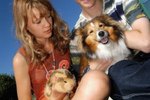Chinese dwarf hamsters are one of the smallest pet hamster breeds, measuring approximately 2 inches at full maturity. These tiny creatures are characterized by a white underbelly, grey-brown top coat and a dark stripe along the back. A generally docile pet, Chinese dwarf hamsters typically do well when housed in same-sex pairs, preferably littermates.
Breeding and Lifespan
The gestation period for a Chinese dwarf hamster is 18 to 25 days, with an average litter containing four to six pups. Young hamsters reach breeding maturity by 8 weeks of age, and if housed with siblings, should be separated into gender-specific housing units at this time to avoid unintentional breeding. Dwarf hamsters typically live 1 to 2 1/2 years.
Housing
Because of their diminutive size, Chinese dwarf hamsters can often escape from wire cages. Opt for an aquarium-style tank or a tight-locking plastic commercial house to keep your hamster safe and secure. Use aspen or timothy hay for bedding, but avoid cedar and pine, which can cause respiratory problems. Provide a hiding place for your hamster, like a plastic commercial hut or structure.
Food
Chinese dwarf hamsters do best on a commercial hamster food blend supplemented with fresh leafy vegetables and fruits every few days. Avoid providing too many high-fat snacks, like nuts, and never allow your hamster to eat candy or sugary processed foods. Provide fresh water in a gravity water bottle at all times to ensure full hydration and healthy digestive function.
Behavior
Chinese dwarf hamsters are curious creatures who like to play, especially with age mates. They like to run, burrow in bedding and chew up things like paper towels and pieces of untreated, unpainted cardboard. As nocturnal animals, they are most active at night, and can be startled and bite if they are woken up during the day.
Handling and Play
Dwarf hamsters are very fast, and should be handled carefully, especially by children. Let your hamster get his energy out by putting an exercise wheel in his cage, and provide a plastic hamster ball for him to run in around your home. Always supervise your hamster when he is in his ball and make sure he can’t fall down stairs, roll outside or run into any other hazards.
Health
Wet tail is the most common health issue of a dwarf hamster, characterized by diarrhea. Dwarf hamsters are also susceptible to respiratory illness. If your hamster appears listless, refuses to eat or shows signs of shaking or wheezing, seek medical attention immediately.
References
Writer Bio
Lisa McQuerrey has been a business writer since 1987. In 1994, she launched a full-service marketing and communications firm. McQuerrey's work has garnered awards from the U.S. Small Business Administration, the International Association of Business Communicators and the Associated Press. She is also the author of several nonfiction trade publications, and, in 2012, had her first young-adult novel published by Glass Page Books.



